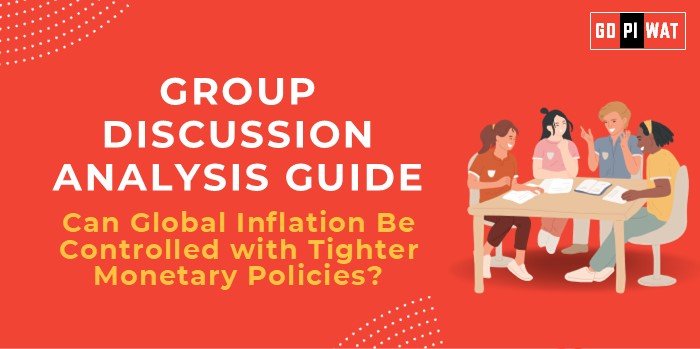📋 GD Analysis Guide
📈 Can Global Inflation Be Controlled with Tighter Monetary Policies?
🌟 Introduction to Global Inflation and Monetary Policies
Context Setting: Inflation remains one of the primary challenges impacting global economies, fueled by supply chain disruptions, geopolitical tensions, and pandemic-related fiscal policies. The role of central banks in combating inflation through monetary policies has come into focus as economies strive to maintain stability.
Background: Global inflation rates surged post-pandemic due to expansive fiscal measures and supply constraints. Tighter monetary policies, such as raising interest rates, are standard tools central banks use to curb inflation by reducing money supply and dampening demand.
📊 Quick Facts and Key Statistics
- 🌍 Global Inflation Peak (2022): Inflation rates reached multi-decade highs, with the U.S. peaking at 9.1% (June 2022) and the Eurozone at 10.6% (October 2022).
- 💰 Interest Rate Hikes (2022-2023): The U.S. Federal Reserve raised interest rates by 525 basis points, marking its most aggressive cycle since the 1980s.
- 🥖 Global Food Prices: The FAO Food Price Index fell 20% from its March 2022 peak but remains above pre-pandemic levels.
- 🇧🇷 Emerging Markets’ Rate Hikes: Brazil raised its policy rates to 13.75% in 2022, showcasing the tougher challenges faced by emerging economies.
- 🌎 Global Recession Risks (2023-2024): The IMF estimates over 30% of the world’s economies face recession risks due to aggressive monetary tightening.
🔍 Stakeholders and Their Roles
- 🏦 Central Banks: Implement monetary policies to control inflation by influencing money supply and demand.
- 🌐 Governments: Influence fiscal policies, which can complement or counteract monetary measures.
- 🏢 Businesses: Face cost pressures due to inflation and higher borrowing costs from interest rate hikes.
- 👥 Consumers: Experience changes in costs of goods and services, influencing spending behavior.
- 🌍 International Organizations: Provide policy guidance and support frameworks for global financial stability.
🏆 Achievements and Challenges
Achievements:
- 📉 Slowing Inflation: Gradual reduction in inflation rates in major economies like the U.S. after aggressive rate hikes.
- 💱 Currency Stabilization: Monetary tightening stabilized currencies against the dollar in some emerging markets.
Challenges:
- ⚖️ Recession Risks: Aggressive tightening raises the risk of economic contraction in vulnerable economies.
- 🔗 Supply Chain Pressures: Monetary policies have limited impact on resolving supply-side issues driving inflation.
- 🌐 Global Comparisons: Japan’s loose monetary policies highlight alternative strategies but reflect specific economic conditions.
Case Study: The U.S. Federal Reserve’s aggressive rate hikes from 2022-2023 curbed inflation but caused temporary market turbulence, demonstrating the trade-offs of tighter monetary policies.
📄 Structured Arguments for Discussion
- ✅ Supporting Stance: “Tighter monetary policies are essential to curb demand-driven inflation, as demonstrated by recent interest rate hikes lowering inflation in major economies.”
- ❌ Opposing Stance: “Tighter monetary policies may induce recession and do not address supply-driven inflation, risking economic stagnation.”
- ⚖️ Balanced Perspective: “Monetary policies can mitigate demand-side inflation but must be complemented by fiscal policies and structural reforms for long-term stability.”
✨ Effective Discussion Approaches
- 📜 Opening Approaches:
- “Global inflation surged to multi-decade highs post-pandemic, necessitating swift action from central banks.”
- “The U.S. Fed’s rapid interest rate hikes offer a case study on the efficacy and challenges of tighter monetary policy.”
- 💬 Counter-Argument Handling:
- “While tighter policies curb demand-driven inflation, addressing supply chain issues through fiscal measures is critical.”
🔍 Strategic Analysis of Strengths and Weaknesses
- 💪 Strengths: Quick response to demand-side inflation, proven track record in stabilizing economies.
- ⚠️ Weaknesses: Risks of economic contraction, limited impact on supply-driven inflation.
- 🌱 Opportunities: Structural reforms and strengthened currency stability.
- 🚨 Threats: Recession risks and financial instability in vulnerable economies.
📚 Connecting with B-School Applications
- 💼 Real-World Applications: Relate to macroeconomic modeling, central banking strategies, and finance projects on policy impact analysis.
- 🎓 Sample Interview Questions:
- “What is the role of central banks in controlling inflation?”
- “Can monetary policy alone manage global inflation effectively?”
- 💡 Insights for B-School Students: Explore implications on capital markets, corporate finance strategy, and global trade analysis.


